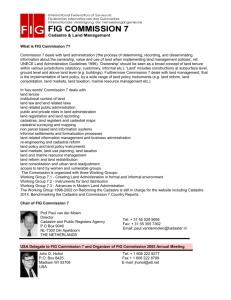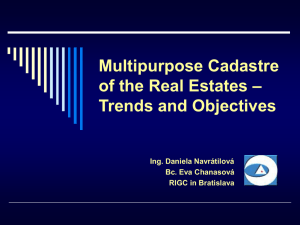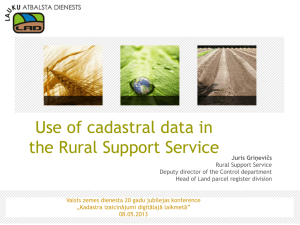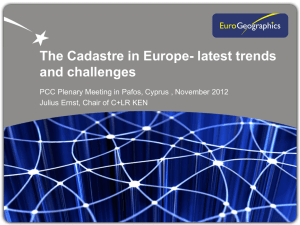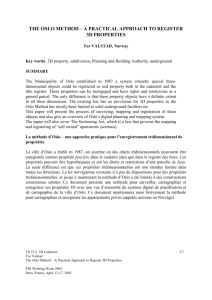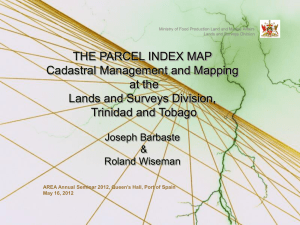the oslo method – a practical approach to register 3d properties
advertisement
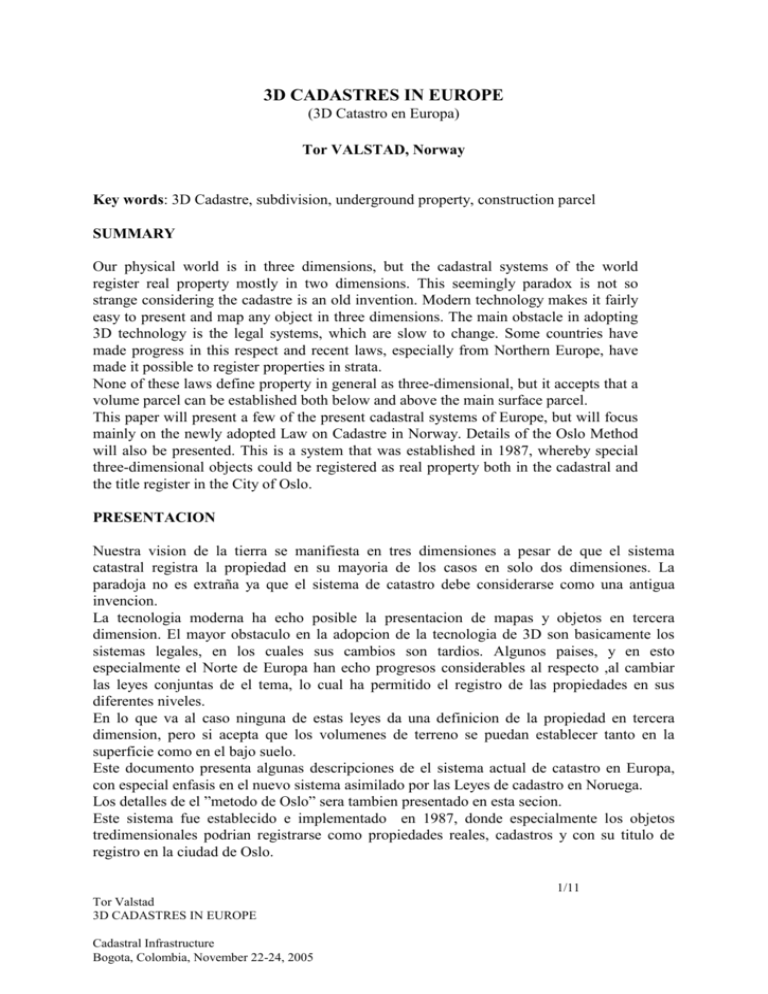
3D CADASTRES IN EUROPE (3D Catastro en Europa) Tor VALSTAD, Norway Key words: 3D Cadastre, subdivision, underground property, construction parcel SUMMARY Our physical world is in three dimensions, but the cadastral systems of the world register real property mostly in two dimensions. This seemingly paradox is not so strange considering the cadastre is an old invention. Modern technology makes it fairly easy to present and map any object in three dimensions. The main obstacle in adopting 3D technology is the legal systems, which are slow to change. Some countries have made progress in this respect and recent laws, especially from Northern Europe, have made it possible to register properties in strata. None of these laws define property in general as three-dimensional, but it accepts that a volume parcel can be established both below and above the main surface parcel. This paper will present a few of the present cadastral systems of Europe, but will focus mainly on the newly adopted Law on Cadastre in Norway. Details of the Oslo Method will also be presented. This is a system that was established in 1987, whereby special three-dimensional objects could be registered as real property both in the cadastral and the title register in the City of Oslo. PRESENTACION Nuestra vision de la tierra se manifiesta en tres dimensiones a pesar de que el sistema catastral registra la propiedad en su mayoria de los casos en solo dos dimensiones. La paradoja no es extraña ya que el sistema de catastro debe considerarse como una antigua invencion. La tecnologia moderna ha echo posible la presentacion de mapas y objetos en tercera dimension. El mayor obstaculo en la adopcion de la tecnologia de 3D son basicamente los sistemas legales, en los cuales sus cambios son tardios. Algunos paises, y en esto especialmente el Norte de Europa han echo progresos considerables al respecto ,al cambiar las leyes conjuntas de el tema, lo cual ha permitido el registro de las propiedades en sus diferentes niveles. En lo que va al caso ninguna de estas leyes da una definicion de la propiedad en tercera dimension, pero si acepta que los volumenes de terreno se puedan establecer tanto en la superficie como en el bajo suelo. Este documento presenta algunas descripciones de el sistema actual de catastro en Europa, con especial enfasis en el nuevo sistema asimilado por las Leyes de cadastro en Noruega. Los detalles de el ”metodo de Oslo” sera tambien presentado en esta secion. Este sistema fue establecido e implementado en 1987, donde especialmente los objetos tredimensionales podrian registrarse como propiedades reales, cadastros y con su titulo de registro en la ciudad de Oslo. 1/11 Tor Valstad 3D CADASTRES IN EUROPE Cadastral Infrastructure Bogota, Colombia, November 22-24, 2005 INTRODUCTION Land has traditionally been described and registered in two dimensions. Accordingly all cadastral systems of the world are in fact two-dimensional. There is an increasing demand for space in the worlds built up areas and both space above and below the surface are being utilised. The cadastral systems should therefore reflect the actual situation and not only the surface parcel. This need to register ownership to volumes has been solved differently in various countries. In most cases the actual volume is not registered as a separate entity, but is linked to the surface parcel in a descriptive way for example by an easement. For many countries this is not sufficient any more, as the owners of the 3D structures might not be the same as the surface parcels. They want their ownership registered in a proper way as constructions above or below ground usually are quite expensive. This pressure to describe and register 3D structures or properties has led to some special solutions in some countries. The main obstacle has been the national legal system and the fact that there was no provisions in the cadastral law to create 3D property units. To my knowledge no country has established a legal system where the parcel system in itself is three-dimensional. This will be the future of a full 3D cadastre. But a few countries have recent laws that provides for the registration of specialised 3D parcels though the cadastral system itself is still 2D. Both Norway and Sweden has passed laws that make it possible to register 3D “construction parcels”. Also in the Netherlands there is a possibility to register data on underground constructions in the cadastre, but not as a separate unit. British Columbia in Canada and Queensland in Australia have provisions in their laws to subdivide land into 3D parcels, though there are some limitations. There has also been a development towards 3D in mapping, laser scanning, GIS and CADsystems. This means there exists systems that can describe and map complex constructions. The technology exists to present any kind of unit in 3D. Denmark, Israel, Greece, Turkey and some other European countries have established some systems for mapping and registering 3D properties, but so far only in connection with research. EUROPEAN CADASTRAL SYSTEMS Europe has three main cadastral systems based on the German, French and the English system. The French or the Roman system is based on a deeds system where the transaction is recorded or the German and English title system where the title itself is recorded and secured. Israel Most of the existing cadastral systems are 2D and deals only with properties on the surface of the land. The existing cadastral systems, due to being surface and 2D, are unsuitable for the multilayer reality that has evolved in recent decades. In order to facilitate the continued establishment of engineering projects below and above the surface, and particularly to enable the registration of properties that are not on the surface, it is necessary to amend the legislation and define a new multilayer and 3D cadastral model. A number of actions have been initiated in Israel in preparation for the 3D cadastre, including 2/11 Tor Valstad 3D CADASTRES IN EUROPE Cadastral Infrastructure Bogota, Colombia, November 22-24, 2005 the government financed R&D project. The final results of the R&D project, will hopefully lead to the realization of the 3D cadastre in Israel and will assist the authorities in the transition period. Greece Greece do not have a 3D cadastre, but as is often the case, they have promoted the concept through various well documented projects. A contemporary 3D Cadastral system should evolve through: the modernization of the relative legal frame and its evolution to a Cadastral Code, defining every different type of ownership right and the way it should be registered and managed. the reformation of the specifications of the project in order to include the registration formula of complex legal rights. So, a categorization of the legal rights is necessary in order to achieve the smoothest, fastest and most economical transition from the bidimensional registration to the 3D Cadastre: old complex properties could be declared parts of traditional settlements and preserved as they are, or they could be marked for monitoring – so if and when the parameter that makes them complex disappears, they would return to a simple property status newer properties developed during the period that the Civil Code was in value, (no floorownership), could be treated respectively a legal frame should be developed, for the properties to be formed in the future the existing records of the Cadastral database should keep on being valid, progressively appending to them a field for the hypsometrical information of the properties and occasionally transforming them to 3D Cadastral records properties with simple ownership status, should update their database information by providing a floor reference (floor number). the inevitable transition of the Real Estate legislation, to the state that any property can exist not necessarily connected to a land-parcel Turkey The Cadastre Law of Turkey accepted in 1985 to include 3D cadastral bases. Although the obligation of 3D cadastre are described and explained by the laws, only 2D objects have been created so far. So cadastral bases and maps have not been produced in a third dimension. There are many big engineering projects carried out to open new areas for public use in the metropolitan areas, because of scarcity of vacant land for development. The 3D cadastral bases and data are necessary for using space below and above for constructing engineering structures and objects. In the land registry there are some difficulties to register the ownership and other rights of real estate objects below or above the surface. In Turkey there are legal problems to register public utilities, underground public garages, metro stations, underground shopping centres etc. 3/11 Tor Valstad 3D CADASTRES IN EUROPE Cadastral Infrastructure Bogota, Colombia, November 22-24, 2005 Denmark The main objective of the Danish cadastral registration is to support an efficient land market, as well as to provide a basis for appropriate land management. Consequently, the cadastre and the land registry should not only secure rights on real properties but also provide insight in the legal status of real properties. Concerning 3D, the current Danish cadastre does not provide insight into the third dimension for a number of reasons. Since information on real estate is maintained in four different registrations, information on real properties in general is not straightforward accessible. Different registrations need to be queried to get insight in the factual situation. The Danish cadastre does not contain any information on 3D situations. The cadastre does not maintain: information on different types of land use on one parcel (only the main use of a parcel is maintained) information on rights, restrictions and subjects of rights and restrictions (with the exception of public restrictions) The Netherlands In Dutch practice the legal status of most 3D situations is secured using apartment rights or right of superficies established on surface parcels. In case of apartment rights, spatial information is available in the land registration using the legally prescribed drawings including cross sections. Although not strictly 3D, a drawing of each vertical layer is provided. In case a right of superficies is established in general no drawings are available in the land registration. Only in case of apartment units, the 3D property unit is known in the (administrative part of the) cadastral registration. In both cases the 3D property unit is not incorporated in the spatial part of the cadastral registration, with the exception that outlines of underground objects can be inserted into the topographic part of the cadastral database (which is not part of the cadastral map) by using a specific classification and visibility code. Current cadastral registration of 3D situations can be accomplished by a notification in the cadastral registration specified with an ‘OB’ code (Ondergronds Bouwwerk: underground construction). Such a notification is registered on a parcel. The OB notification indicates that something is located below the surface, whereupon the user can do further examination in the land registration (see section 2.5). The legal documents recorded in the land registration describe which rights are established on the intersecting parcels and may be accompanied by a drawing. The OB code does not say anything about the legal status of the 3D property situation. In addition, this solution only covers constructions below the surface and covers therefore only part of the 3D situations. Sweden A new Swedish law that facilitates 3D property units came into force in January 2004. The law was prepared by a committee, appointed by the Swedish government in 1994, to investigate the potentials for solving the problems of different types of use in one building. The main conclusion of the committee was that the most appropriate solution would be the possibility to establish 3D property similar to 2D property. 3D properties can then be 4/11 Tor Valstad 3D CADASTRES IN EUROPE Cadastral Infrastructure Bogota, Colombia, November 22-24, 2005 mortgaged and information on the 3D properties is accessible through the real property register. The main objection which came to the proposal was that the fundamental property concept should not be altered from 2D since the cases of 3D are limited. Therefore the new 3D properties had to fit within the structure of 2D properties. The following criteria have been set up for 3D properties: Title must be in perpetuity Title shall, as far as possible, be independent of the (land) property within whose parcel column it is located and shall be separately transferable, without any simultaneous transfer of the surface land A 3D property must be an object for credit; public authorities, credit providers and other outsiders shall have the possibility to obtain information on the rights established on the property The new rules should as far as possible be in accordance with the existing principles of real property law The ultimate aim of 3D property formation is to create better opportunities for 3D property use and also for such properties to be capable of serving as security for the grant of credits 3D property formation is only permitted if it accommodates, or intends to accommodate, a building and if it is assured of the rights necessary to its appropriate use (e.g. rights for joint facilities, easements). To avoid empty airspace property units, the 3D property has to relate to a real construction. When it is related to a construction to be built, the cadastral authority can set a deadline for the completion of the construction. Unlike in Norway a building itself may be divided into different property units. This is also the main type of ownership situation that the new law wants to facilitate. However, a 3D property for housing purposes should contain at least five apartment units, which means that the new legislation does not provide scope for the creation of apartments. Norway Though the registration of land in Norway has been regulated since the thirteenth century, it is only after the Land Subdivision Act came in 1978, that the whole country has the same identification system for properties. The Land Subdivision Act covers the whole country, but deals only with two-dimensional properties. This made it difficult to identify and register underground structures in a way that satisfied the Land Registrar. In 1987 the Municipality of Oslo developed, in cooperation with the Land Registrar, a cadastral system that could handle three-dimensional objects. A new Law on the Cadastre was passed by the Parliament in June 2005. It is not expected to be enacted before 2007. This new law will replace the land subdivision act and will establish a new national cadastral database that includes a cadastral map and public restrictions on land. The law will introduce private licensed surveyors to replace the current municipal monopoly, though the municipalities can on an individual basis still choose to retain their monopoly. At last it introduces the possibility to establish “construction properties”. These construction properties can be established below the surface of the earth or they can be established above the surface usually as constructions erected on pillars. There is also provisions for establishing constructions at sea or fresh water both for structures built on the seabed or floating, but properly anchored constructions. The construction property unit is partly based on the Oslo 5/11 Tor Valstad 3D CADASTRES IN EUROPE Cadastral Infrastructure Bogota, Colombia, November 22-24, 2005 method so most of the underground volumes created in the City of Oslo will become “legal” under the new law. THE CITY OF OSLO Oslo has a population of 520,000, and a surface area of 454 km², 75 per cent of which consists of forests and other undeveloped land. The build up area is about 112 km² and the total area within the building zone is approx. 146 km². There are 70,000 properties of which the Municipality owns more than 8,000. There are all together 262,000 buildings in Oslo. The City Parliament is Oslo's highest governing body. The authority delegated by the national government to the municipality is conferred on the City Parliament, which is a legislative assembly consisting of popularly elected representatives. Oslo's City Government is the city's highest executive body. The City Government is responsible for preparing and implementing resolutions passed by the City Parliament, through its management of the various departments of the central municipal administration. The central administration is the City Government’s "staff" and it consists of eight municipal departments. The municipal departments correspond to national ministries and comprise of among others The Department of Urban Planning. This department is again responsible for several municipal corporations and offices and the Agency for Planning and Building Services is one of them. THE AGENCY FOR PLANNING AND BUILDING SERVICES This agency was established as a new organisation in 1992 and reorganised in 2003 and combines building control, planning, surveying, mapping and land registration. Planning In Oslo the property developers produce almost all local development plans. The task of the Planning and Building Authority is to ensure that strategically planning objectives such as, city form, landscape elements, green structure, transportation, public services and facilities etc. are secured. The Norwegian Planning and Building Act contain no clauses that requires underground areas to be planned or mapped or described in the written regulations. Although there is no legal obligation to include underground structures in our development plans, such practice has been included as part of our standard of documentation in the Agency. The practise of including underground areas into the development plans was developed when the city's first underground tramway was constructed around 1898. In 2005 the office will receive around 115 local development plans. Building The Agency for Planning and Building Services has been delegated the authority to decide virtually all building applications. The requirement to obtain a building permission covers a wide spectre of objects from the construction of dollhouses in the garden, fences and billboards to new constructions of any dimension including underground structures. In making their 6/11 Tor Valstad 3D CADASTRES IN EUROPE Cadastral Infrastructure Bogota, Colombia, November 22-24, 2005 decision the planning authority must have regard to the provisions of the building and local development plans adopted by the city. The agency will receive close to 7,000 building applications in 2005. Mapping The city of Oslo was originally covered with base maps in 1:500 and 1:1,000. Since 1996 the whole area has been covered by digital maps that are updated by photogrammetry every third year. Every kind of map is now digital and they are available through the computer network. The user decides how much information should be made available on the screen or printout. The original base map with half meter contours, depicts the necessary detail as well as administrative and property boundaries with parcel numbers. This map also shows the extent of underground utilities, tunnels of all kinds, areas for underground storage and car parking etc., but only in the vertical projection as a horizontal plan. The mapping system contains cadastral information such as boundaries and parcel registration number. The user can assess the quality of the boundaries and the method of acquisition. Underground parcels are marked only with their footprints on the map. The urban planning map is derived from the base map and contains information about area plans, local development plans and building plans as an overlay to the base map. The land use information is very detailed and contains references to the various plans and regulations. Even underground areas are marked with their specific purpose and referenced to a certain municipal regulation. The urban planning map series is also fully digitised and covers the whole building zone. The public can buy colour printouts of this map at the information desk and this is the map that the public are required to use in connection with an application for subdivision or building. The various maps can be combined with digital orthophotos. In addition oblique aerial photographs, with a very high resolution, cover the urban areas. THE CADASTRAL SYSTEM OF NORWAY The Norwegian cadastre is a parcel-based land information system. Both the national and local government has issued regulations to ensure that the boundaries of real property and leased land are accurately marked, measured and mapped, and furthermore that an updated and reliable register are kept of all real property and leased land and of data connected with the same. Identification of parcels All land in a municipality is divided into fixed number of large areas, which each is given a main registration number. These areas are then subdivided into parcels and numbered in succession by a parcel number. Within a municipality a parcel is uniquely identified with an area and parcel number, eight digits in all. On a national level four more digits are added to identify the municipality. The City of Oslo is divided into approximately 250 areas. An underground parcel is given the same area number as the parcel on the surface, but with 300 added. The parcel number starts at 7/11 Tor Valstad 3D CADASTRES IN EUROPE Cadastral Infrastructure Bogota, Colombia, November 22-24, 2005 one. This gives each underground parcel a distinct identification and with a relationship to the surface property as well. Area numbers from 601-900 are reserved for parcels above the ground. The system made provisions for subdivision of parcels above the ground, but so far it has only been utilised for parcels below the ground. Registration Since 1980 a national GAB-register system has been developed. This information system embraces properties, addresses and buildings, and currently contains nationwide some 3 million properties. All the municipalities in Norway report directly to the GAB database. The Norwegian Mapping Authority is responsible for the GAB-register. The Land Registrar has his own Electronic Property Register. Information about ownership is transferred from the Electronic Property Register to the GAB-register on a daily basis. The national property register (GAB) is at present only a textual database with no connection to a topographic or cadastral map. Some of the bigger cities have introduced local solutions with easy cross-references between map and property information. The new law on cadastre introduces this solution on a national level. A national cadastre with both cadastral information and a corresponding digital cadastral map will be made available in 2007. Procedure The Land Subdivision Act regulates both the survey work and the administrative routines of the subdivision process that is required to have a new parcel properly identified. The whole process is a municipal responsibility. Private companies can do part of the process, but since every municipality has its own surveying unit, it is not very common. The new law on cadastre will partly end this municipal monopoly as it opens up for private surveyors from licensed companies. Division of a parcel starts with an application from the titleholder. A map showing the desired new boundary should accompany the application. The local subdivision board has to decide whether the subdivision should be permitted according to existing land use and local development and building plans. The subdivision-permission will not be granted if the area is too small to build a house. It is also necessary to have acceptance regarding access road, water and sewage before a final permission is given. The parcel is then surveyed and the new boundary marked. The process always includes a meeting in the field with the applicant and the neighbouring landowners. The cadastral surveyor can act as an arbitrator if there is a dispute about an existing boundary. The surveyor may decide the delineation of the boundary providing all parties accept. Under the present subdivision act the cadastral surveying is part of the municipal administration, but under the coming law this activity will become a service that can be carried out either by municipal or private surveyors. Underground parcels The subdivision of underground parcels follows partly the same procedure as for surface parcels. The titleholder on the surface has to agree to give up his rights to the underground. In 8/11 Tor Valstad 3D CADASTRES IN EUROPE Cadastral Infrastructure Bogota, Colombia, November 22-24, 2005 Norway there has not been established a finite depth of ownership. But usually ownership downwards has been accepted as far as you are able to utilise it. Which means that private landowners outside the central business district are seldom compensated for tunnels under their property, even if only 10-30 metres below the basement. Acquisitions of underground areas for public tunnels are usually done by occupation. In a few cases underground areas have been expropriated and compensated because of future restrictions of the landowner's possibility to build below the ground. When a national or municipal agency is involved in underground construction, the finished volume is seldom subdivided from the surface parcel. If it is necessary to reach an agreement with the landowner, a restrictive clause will be added to the title deed of the land at The Land Registrar. To establish a 3D parcel you have to get a building permit which is valid for three years. A 3D parcel in Norway cannot be established without something being built or it has to relate to an existing construction. There is not any possibility to register volumes of air or rock just to confirm your ownership or to reserve the volume for future use. Neither is it possible to establish a 3D parcel independently from the surface parcel. The surface parcel is the main property object and “construction properties” are only limited volumes connected to the surface parcel though they can be connected to multiple surface parcels. Constructions on the seabed provides a special solution. The seabed is seldom divided into parcels so when a “construction property” according to the new law is established in the sea or on the seabed there is no parcel to subdivide it from. How this procedure should be carried out will hopefully be explained in the coming regulations connected to the law. 3D CADASTRAL SURVEYING The City of Oslo is involved in the process when a private person or company or a municipal corporation wants to build below others property. The application process is similar to surface subdivisions, but the cadastral surveying is somewhat different. It is of course impossible to set out the desired underground area beforehand so we are reduced to accept the plans and drawings from the applicant. Usually we accept the drawings as the final result and issue a survey certificate without any surveying. The section for cadastral surveying employs a reflectorless total station and many underground parcels are now surveyed both at the bottom and at the top, such that the underground parcels are identified as exact volumes. On the survey certificate, each corner is given coordinates and heights at the floor and at the ceiling. The registration number and the survey identify the parcel as a volume, but in the various registers the parcels size is given in square metres and not in cubic metres. A new law that will replace The Land Subdivision Act is under way and this law will make it easier as well as legal to operate with three-dimensional parcels. UNDERGROUND CONSTRUCTION Norway is not a densely populated country and it would look like it is enough space to build whatever above the ground. But even outside the city centres there is a lot of underground construction. This is partly due to the topography of Norway and that modern techniques have made it possible and economically viable to make tunnels and caverns everywhere. Another important fact is that Norwegians regard their mountains, forests and recreational areas as almost sacred, which makes it politically dangerous to infringe on these areas. In many cases it 9/11 Tor Valstad 3D CADASTRES IN EUROPE Cadastral Infrastructure Bogota, Colombia, November 22-24, 2005 is cheaper as well, because it reduces noise pollution measures, traffic accidents, maintenance costs and of course the acquisition costs. The underground of Oslo have been heavily utilised in the recent years. Especially in connection with feasibility studies it would reduce costs if a complete 3-D map of the underground were available. THREE-DIMENSIONAL UNDERGROUND MAP Even though most underground activities are marked on the municipal maps there is no central register for three-dimensional maps and information. Today's maps do not show the underground structures position in relationship to the surface or to other underground structures. In the inner city area this may not be sufficient anymore, neither for planners nor developers. It has long been the intention of the Agency for Planning and Building Services to develop a three-dimensional underground map. But there are legal, political, financial and technological obstacles so a solution is still in the future. APARTMENTS In Norway we have a law on condominiums, which governs the way flats can be subdivided or sectioned in order to establish ownership. It is the municipalities that deal with these cases. The application for sectioning is followed by plans for each floor where the various flats (sections) are marked. There is no surveying involved in the making of these plans. But if the owner of a flat (section) wants exclusive rights of an outdoor area, surveying might be necessary to determine area and boundaries. The sections are entered into the GAB-register as an ownership unit. One restriction is that sectioning is only possible if all the flats in the building are involved. Both commercial and private buildings can be sectioned and there is an overlap between the Sectioning Act and the Subdivision Act so in a few cases the client can choose the procedure himself. In some cases a three-dimensional approach might have been better, but the present process is fairly rapid and cheap. REFERENCES C. Coskun Aydin, Osman Demir and Mustafa Atasoy: Third Dimension (3D) in Cadastre and Its Integration with 3D GIS in Turkey, FIG Working Week, Athens May 2004 Enemark, Stig, A Cadastral Tale, Week on Geomatics, Bogota, Colombia 2005 Jantien E. Stoter, Peter J. M. van Oosterom, Hendrik D. Ploeger and Henri J. G. L. Aalders: Conceptual 3D Cadastral Model Applied in Several Countries, FIG Working Week, Athens May 2004 Jantien Stoter, Esben Munk Sørensen and Lars Bodum: 3D Registration of Real Property in Denmark, FIG Working Week, Athens May 2004 Julstad, B. and A. Ericsson, 2001, Property formation and three-dimensional property units in Sweden, FIG Workshop on 3D cadastres, November, Delft, 2001. 10/11 Tor Valstad 3D CADASTRES IN EUROPE Cadastral Infrastructure Bogota, Colombia, November 22-24, 2005 Mary Papaefthymiou, Tassos Labropoulos and Panagiotis Zentelis: 3D-Cadastre in Greece Legal, Physical and Practical Issues: Application on Santorini Island, FIG Working Week, Athens May 2004 Mattsson, H., 2003, Towards Three Dimensional Properties in Sweden, European Faculty of Land Use and Development, 32nd International Symposium, 24-25 October 2003, Strasbourg. Onsrud, H., Making laws for 3D cadastre in Norway, FIG Congress, Washington, USA, April 2002. Uri Shoshani, Moshe Benhamu, Eri Goshen, Saul Denekamp and Roy Bar: Registration of Cadastral Spatial Rights in Israel – A Research and Development Project, FIG Working Week, Athens May 2004 Valstad, T., 2003, The Oslo Method: a practical approach to register 3D properties. FIG Working Week, Paris, France, April, 2003. BIOGRAPHICAL NOTES Head of Cadastre in the City of Oslo 1993 – 2000, 2003 -. Cadastral Programme Manager at the Kosovo Cadastral Agency in Pristina, Kosovo 2000 2002. Earlier experience in engineering surveying, land, geodetic, hydrographical and quantity surveying. Secretary of FIG Commission 3 from 1996 to 2002. CONTACTS Name: Institution: Office address: Home address: Telephone: Fax: Mobile: E-mail: Web site: Tor VALSTAD The Agency for Planning and Building Services City of Oslo, Norway Postboks 364 Sentrum N-0102 Oslo Norway Ulsrudveien 25 N-0690 Oslo Norway + 47 23 491267 + 47 23 491240 (+47) 982 36 571 tor.valstad@pbe.oslo.kommune.no torvalstad@hotmail.com http://www.pbe.oslo.kommune.no 11/11 Tor Valstad 3D CADASTRES IN EUROPE Cadastral Infrastructure Bogota, Colombia, November 22-24, 2005
